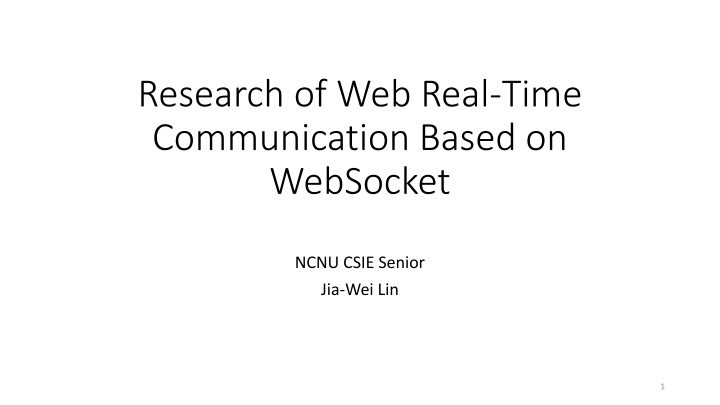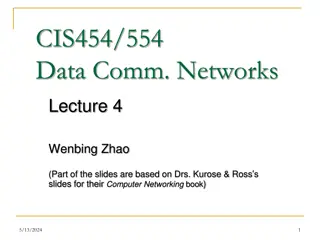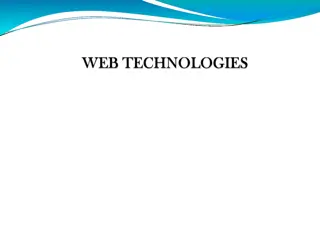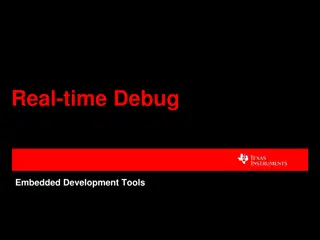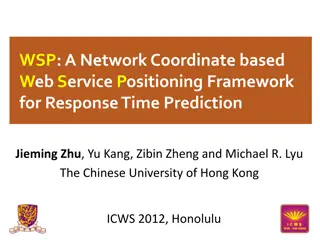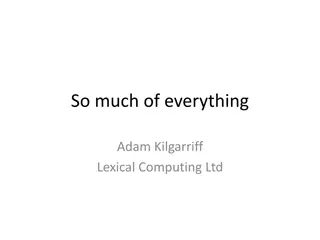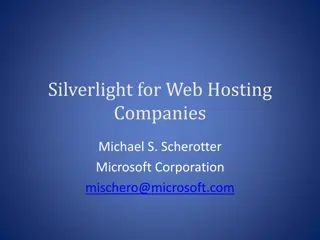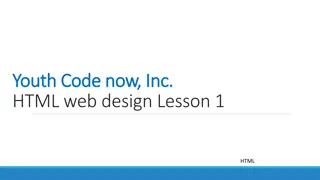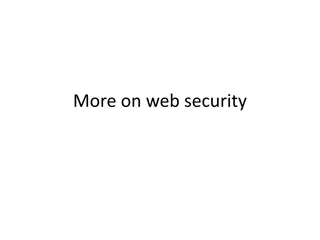Real-Time Web Communication using WebSocket
This research explores the benefits of WebSocket over traditional methods like AJAX, Polling, Comet, and Long-polling for enabling real-time communication on the web. It discusses the challenges with HTTP-based approaches and how WebSocket offers a more efficient and low-latency solution. The comparison of various techniques and their impact on web performance is presented with illustrative examples.
Download Presentation

Please find below an Image/Link to download the presentation.
The content on the website is provided AS IS for your information and personal use only. It may not be sold, licensed, or shared on other websites without obtaining consent from the author.If you encounter any issues during the download, it is possible that the publisher has removed the file from their server.
You are allowed to download the files provided on this website for personal or commercial use, subject to the condition that they are used lawfully. All files are the property of their respective owners.
The content on the website is provided AS IS for your information and personal use only. It may not be sold, licensed, or shared on other websites without obtaining consent from the author.
E N D
Presentation Transcript
Research of Web Real-Time Communication Based on WebSocket NCNU CSIE Senior Jia-Wei Lin 1
Outline Traditional Web Real-Time Communication Solutions HTML5 WebSocket An example to show why we choose WebSocket Summary 2
Traditional Web Real-Time Communication Solutions AJAX Polling Comet Long-polling Streaming 3
AJAX ( A Asynchronous J JavaScript A And X XML ) AJAX applications might use XML to transport data, but it is common to transport data as plain text or JSON text. AJAX is not a programming language. AJAX allows web pages to be updated asynchronously by exchanging data with a web server behind the scenes. Update parts of a web page, without reloading the whole page. 4
Polling The client makes a periodic request in a specified time interval to the Server. Just like the way you refresh web page manually but replaced by auto running program. 5
Comet Comet is a web application model in Request Hold request which a long-held HTTP request allows a web server to push data to a Data updating event browser, without the browser Response explicitly requesting it. 6
Long-polling Browser sends a request and the server keeps the request open for a set period of time. If an event occurs , server response the new coming data to browser, and browser will make another request. If no event occurs , server sends a response to terminate the open request. 7
Streaming Server will never close a connection which sponsored by browser. Sever sends message at any time. 8
The Problems are All of these methods for providing real-time data involve HTTP request and response headers. Unnecessary header data and introduce latency ! Because of HTTP is half-duplex , we use two TCP connections to simulate full-duplex communication over half-duplex HTTP. Significant overhead and complexity! 9
HTML5 WebSockets to the Rescue! WebSocket is a protocol defined in RFC 6455. Full-duplex, bidirectional communications channel over a single TCP connection. Remove the overhead and dramatically reduce complexity. 11
WebSocket Handshake To establish a WebSocket connection, the client and server upgrade from the HTTP protocol to the WebSocket protocol during their initial handshake. 12
Connection Established Once the connection is established, data frames can be sent back and forth between the client and the server in full-duplex mode by WebSocket protocol. The data is minimally framed with just 2 bytes! Payload Header A WebSocket frame in Wireshark WebSocket Frame 13
HTTP WebSocket 14
Reduction in Unnecessary Network Traffic and Latency To illustrate polling, this example will examine a web application in which a web page requests real-time stock data from a web server using a traditional polling model. 15 A JavaScript stock ticker application
HTTP Response Header HTTP Request Header GET /PollingStock//PollingStock HTTP/1.1 Host: localhost:8080 User-Agent: Mozilla/5.0 (Windows; U; Windows NT 5.1; en-US; rv:1.9.1.5) Gecko/20091102 Firefox/3.5.5 Accept: text/html,application/xhtml+xml,application/xml;q=0.9,*/*;q=0.8 Accept-Language: en-us Accept-Encoding: gzip,deflate Accept-Charset: ISO-8859-1,utf-8;q=0.7,*;q=0.7 Keep-Alive: 300 Connection: keep-alive Referer: http://www.example.com/PollingStock/ Cookie: showInheritedConstant=false; showInheritedProtectedConstant=false; showInheritedProperty=false; showInheritedProtectedProperty=false; showInheritedMethod=false; showInheritedProtectedMethod=false; showInheritedEvent=false; showInheritedStyle=false; showInheritedEffect=false HTTP/1.x 200 OK X-Powered-By: Servlet/2.5 Server: Sun Java System Application Server 9.1_02 Content-Type: text/html;charset=UTF-8 Content-Length: 21 Date: Sat, 07 Nov 2009 00:32:46 GMT Request + Response Header = Totally 871 bytes 16
If there are a large number of users Use case A: 1,000 clients polling every second: Total header in network traffic is (871 1,000) = 871,000 bytes = 6,968,000 bits per second (6.6 Mbps) Use case B: 10,000 clients polling every second: Total header in network traffic is (871 10,000) = 8,710,000 bytes = 69,680,000 bits per second (66 Mbps) Use case C: 100,000 clients polling every 1 second: Total header in network traffic is (871 100,000) = 87,100,000 bytes = 696,800,000 bits per second (665 Mbps) 17
Using WebSocket protocol in these cases Use case A: 1,000 clients receive 1 message per second: Total header in network traffic is (2 1,000) = 2,000 bytes = 16,000 bits per second (0.015 Mbps) Use case B: 10,000 clients receive 1 message per second: Total header in network traffic is (2 10,000) = 20,000 bytes = 160,000 bits per second (0.153 Mbps) Use case C: 100,000 clients receive 1 message per second: Total header in network traffic is (2 100,000) = 200,000 bytes = 1,600,000 bits per second (1.526 Mbps) 18
Request 2 Request 3 Request 1 Response 2 Response 1 Response 3 WebSocket Upgrade WebSocket Frame 4 WebSocket Frame 5 WebSocket Frame 1 WebSocket Frame 2 WebSocket Frame 3 20
Summary HTML5 WebSocket provides an enormous step forward in the scalability of the real-time web. WebSocket can provide a 500:1 or - depending on the size of the HTTP headers - even a 1000:1 reduction in unnecessary HTTP header traffic and 2:1 reduction in latency. 21
Reference Peter Lubbers & Frank Greco, Kaazing Corporation , HTML5 web sockets: A quantum leap in scalability for the web. Peter Lubbers, Brian Albers, and Frank Salim ," Chapter 7 Using the WebSocket API" in "Pro HTML 5 Programming", Apress, 2nd edition, 2011. RFC 6455 The WebSocket Protocol W3C School - AJAX introduction RFC 7230 - Hypertext Transfer Protocol (HTTP/1.1): Message Syntax and Routing , session 6.1 and session 6.7 22
